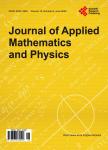Spatio-Temporal Pulsating Dissipative Solitons through Collective Variable Methods
Spatio-Temporal Pulsating Dissipative Solitons through Collective Variable Methods作者机构:Ecole Supérieure Africaine des Technologies de l’Information et de Communication (ESATIC) Abidjan Cote d’Ivoire Department of Electrical and Electronic Engineering Institut National Polytechnique Houphouet Boigny (INPHB) Yamoussoukro Côte d’Ivoire UFR des Sciences des Structure de la Matière et de Technologie de l’Université Félix Houphouet Boigny Abidjan Cote d’Ivoire
出 版 物:《Journal of Applied Mathematics and Physics》 (应用数学与应用物理(英文))
年 卷 期:2016年第4卷第6期
页 面:1032-1041页
学科分类:07[理学] 0701[理学-数学] 070101[理学-基础数学]
主 题:Dissipative Soliton Pulsating Light Pulse Spatiotemporal Pulses Collective Variable Approach Complex Cubic-Quintic Ginzburg-Landau Equation Bifurcation
摘 要:A semi-analytical approach for the pulsating solutions of the 3D complex Cubic-quintic Ginzburg-Landau Equation (CGLE) is presented in this article. A collective variable approach is used to obtain a system of variational equations which give the evolution of the light pulses parameters as a function of the propagation distance. The collective coordinate approach is incomparably faster than the direct numerical simulation of the propagation equation. This allows us to obtain, efficiently, a global mapping of the 3D pulsating soliton. In addition it allows describing the influence of the parameters of the equation on the various physical parameters of the pulse and their dynamics.



